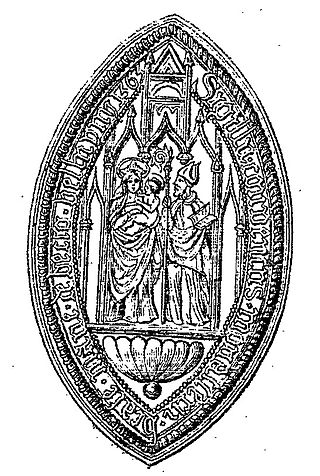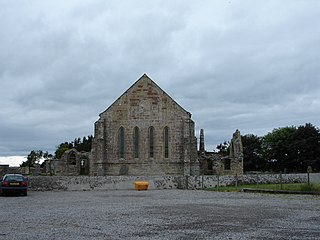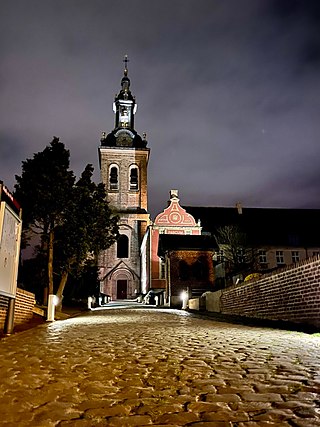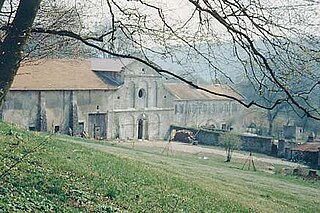
An abbey is a type of monastery used by members of a religious order under the governance of an abbot or abbess. Abbeys provide a complex of buildings and land for religious activities, work, and housing of Christian monks and nuns.

Bec Abbey, formally the Abbey of Our Lady of Bec, is a Benedictine monastic foundation in the Eure département, in the Bec valley midway between the cities of Rouen and Bernay. It is located in Le Bec Hellouin, Normandy, France, and was the most influential abbey of the 12th-century Anglo-Norman kingdom.

The Order of Canons Regular of Prémontré, also known as the Premonstratensians, the Norbertines and, in Britain and Ireland, as the White Canons, is a religious order of canons regular of the Catholic Church founded in Prémontré near Laon in 1120 by Norbert of Xanten, who later became Archbishop of Magdeburg. Premonstratensians are designated by OPraem following their name.

The Abbot of Fearn was the head of the Premonstratensian monastic community of Fearn Abbey, Easter Ross, Scotland. The Abbey was founded by canons from Whithorn Priory in Galloway, with the patronage of Fearchar mac an t-Sagairt, mormaer/earl of Ross. The foundation took place in the 1220s, according to the two distinct foundation dates given in the sources, either in 1221 or in 1227. Until about 1238, the Abbey was located at Fearn, near Edderton, but it was moved to the Tarbat parish in that year and known thereafter as "nova Furnia". Despite the fact that the head of Whithorn Priory was a prior and Fearn an abbot, Fearn seems to have remained subordinate to Whithorn until at least the end of the 14th century, and even in 1440 Abbot Fionnlagh II was confirmed by the prior of Whithorn.The reason for this is that Whithorn was a cathedral priory; the nominal head of its community was the bishop, but its actual head was the prior, as was the common use in England at places like Durham and Carlisle, but this was not usual in Scotland. In these circumstances the cathedral prior had the same rights as an ordinary abbot.

Tupholme Abbey was a Premonstratensian abbey close to the River Witham some 10.5 miles (16.9 km) east of the city of Lincoln, England and one of nine such abbeys within the historical county. The Witham valley in Lincolnshire is notable for its high concentration of monasteries—there were six on the east bank and three on the west—all presumably drawn to the area by the usefulness of the River Witham for transport and by the wealth that it transported. The abbey was largely destroyed by 1538, after being seized during Henry VIII's Dissolution of the Monasteries.

Maillezais Cathedral is a ruined Roman Catholic church in the commune of Maillezais in the Vendée, France. Formerly the site of the Abbey of Saint-Pierre, the site grew from the 10th century abbey to the cathedral completed in the 15th century, with the many structures at the site abandoned by the end of the 17th century. Today's ruins consist of a cathedral, refectory, dormitory, kitchen, cellars, turrets and ramparts. The cathedral has been declared a heritage monument in reflection of its Romanesque and Gothic architectural form. It was designated a monument historique on 30 January 1924. The cathedral belonged to the Diocese of Luçon, with Roman Rites, and with St. Peter as the patron saint.

Park Abbey is a Premonstratensian abbey in Belgium, at Heverlee just south of Leuven, in Flemish Brabant.

L'Étanche Abbey is a former Premonstratensian monastery founded in the 12th century, the ruins of which are near the modern village of Deuxnouds-aux-Bois, in the commune of Lamorville, Meuse, France.

Frigolet Abbey is a grand Premonstratensian monastery complex in Southern France. It is located in the territorial commune of Tarascon, in the region of the Montagnette, the parishes of which are served by the canons of the monastery. It was originally associated with the Order of Saint Benedict.

The Abbey of Saint Bertin was a Benedictine monastic abbey in Saint-Omer, France. The buildings are now in ruins, which are open to the public. It was initially dedicated to Saint Peter but was rededicated to its second abbot, Saint Bertin. The abbey is known for its Latin cartulary whose first part is attributed to Folcwin.

Eustache Restout was a French architect, engraver, painter and Premonstratensian canon regular, belonging to the artistic Restout dynasty. At his death he was sub-prior of abbaye Saint-Martin de Mondaye - he had produced the plans on which that monastery was rebuilt and painted several paintings for it. His students included his nephew Jean II Restout.

The Abbey of the Most Holy Trinity of La Lucerne, also known as La Lucerne Abbey was a Premonstratensian canonry founded in the 12th century. It is situated in the forests of the Thar river valley in the Manche department of Normandy.

Bois-Seigneur-Isaac Abbey is a former Augustinian abbey in Wallonia, then a Premonstratensian priory, dependent on Averbode Abbey and now occupied by the Lebanese Maronite Order. It is located in Ophain-Bois-Seigneur-Isaac, Belgium.

Charroux Abbey is a ruined monastery in Charroux, in the Vienne department of Nouvelle-Aquitaine, western France.

The Abbey of St. Mary of Lagrasse is a Romanesque abbey in Lagrasse, southern France, whose origins date to the 7th century. It is located in Languedoc, near the Corbières Massif, about 35 km from Carcassonne. It was originally a Benedictine monastery, but since 2004 has been home to a community of canons regular.

The Abbey of Our Lady of Ardenne, commonly called Ardenne Abbey, is a former Premonstratensian abbey founded in the 12th century and located near Saint-Germain-la-Blanche-Herbe in Calvados, near Caen, France. It is now occupied by the Institute of Contemporary Publishing Archives. Several buildings of the abbey have been preserved, including the church. These are protected as historic monuments.

Cerisy Abbey, otherwise the Abbey of Saint Vigor, located in Cerisy-la-Forêt, Manche, France, was an important Benedictine monastery of Normandy.

The Abbey of the Holy Trinity is an 11th century Romanesque Benedictine Abbey church located in Lessay, Manche, France, then in Normandy. The abbey is one of the most important Norman Romanesque churches, and, along with Durham Cathedral, one of the first examples use of the rib vault to cover the choir in about 1098. This element became a key feature of Gothic architecture. The abbey was nearly destroyed in 1357. It was destroyed in 1944 and subsequently rebuilt.

Sainte-Marie-au-Bois is a former abbey of the Premonstratensians order, located in the commune of Vilcey-sur-Trey, Meurthe-et-Moselle, France, built near a spring at the bottom of a small valley where a tributary of the Trey flows. Long considered the oldest settlement of the Premonstratensians order in Lorraine, its abbot in the early 17th century was Servais de Lairuelz, who led the reform of his order, first in Lorraine and then beyond. At the start of the First World War, French writer and poet Charles Péguy stayed at the former abbey, now a farm. Today, its remarkable remains make Sainte-Marie-au-Bois a rare architectural reminder of the Prémontré order in the 12th century.























